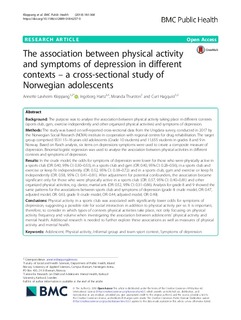The association between physical activity and symptoms of depression in different contexts – a cross-sectional study of Norwegian adolescents
Peer reviewed, Journal article
Published version
Permanent lenke
http://hdl.handle.net/11250/2589032Utgivelsesdato
2018Metadata
Vis full innførselSamlinger
Sammendrag
Background The purpose was to analyse the association between physical activity taking place in different contexts (sports club, gym, exercise independently and other organized physical activities) and symptoms of depression. Methods The study was based on self-reported cross-sectional data from the Ungdata survey, conducted in 2017 by the Norwegian Social Research (NOVA) institute in cooperation with regional centres for drug rehabilitation. The target group comprised 5531 15–16 years old adolescents (Grade 10 students) and 11,655 students in grades 8 and 9 in Norway. Based on Rasch analysis, six items on depressions symptoms were used to create a composite measure of depression. Binomial logistic regression was used to analyse the association between physical activities in different contexts and symptoms of depression. Results In the crude model, the odds for symptoms of depression were lower for those who were physically active in a sports club (OR: 0.40, 95% CI: 0.30–0.53), in a sports club and gym (OR: 0.40, 95% CI: 0.28–0.56), in a sports club and exercise or keep fit independently (OR: 0.52, 95% CI: 0.38–0.72) and in a sports club, gym and exercise or keep fit independently (OR: 0.58, 95% CI: 0.41–0.81). After adjustment for potential confounders, the association became significant only for those who were physically active in a sports club (OR: 0.57, 95% CI: 0.40–0.81) and other organized physical activities, e.g. dance, martial arts (OR: 0.52, 95% CI: 0.31–0.86). Analysis for grade 8 and 9 showed the same patterns for the associations between sports club and symptoms of depression (grade 8: crude model, OR: 0.47, adjusted model, OR: 0.63, grade 9: crude model, OR: 0.44, adjusted model, OR: 0.49). Conclusions Physical activity in a sports club was associated with significantly lower odds for symptoms of depression, suggesting a possible role for social interaction in addition to physical activity per se. It is important, therefore, to consider in which types of contexts physical activities take place, not only focusing on physical activity frequency and volume when investigating the association between adolescents’ physical activity and mental health. Additional research is needed to further explore these associations as well as measures of physical activity and mental health.
